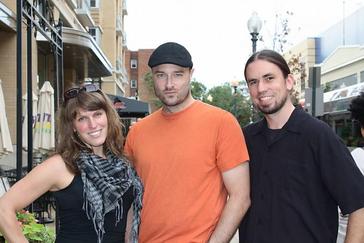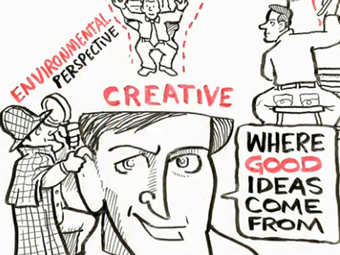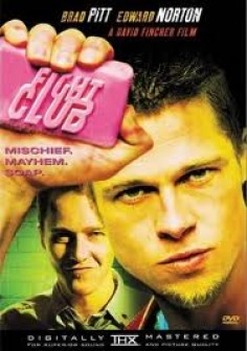|
Originally posted on Norton Sociology  from left to right: Valerie Chepp, Lester Andrist, Paul Dean from left to right: Valerie Chepp, Lester Andrist, Paul Dean
_
The editors of The Sociological Cinema—Valerie Chepp, Paul Dean, and Lester Andrist—were recently named Norton's Sociologists of the Month! As part of this honor, Norton's Andrea Lam interviewed us about the website, media, and popular culture. Read the full interview here. A CONVERSATION WITH ANDREA LAM Q: What were the origins of The Sociological Cinema, and what are your goals for the project? PAUL: Like most good ideas, this one started in a bar. Valerie and I chatted about how much we enjoyed working together (we also co-authored a chapter that analyzes Jack Kerouac’s On the Road from a sociological perspective) and how much we were both enjoying teaching sociology, despite all the other demands on our schedules. Then Valerie made a passing observation about how useful short videos were in her class but lamented that she was spending a lot of time looking for videos that would work. Wouldn’t it be great, she suggested, if there was a place you could go to find videos that were useful for the sociology classroom? Having wasted hours of time on YouTube trying to find clips for class, I immediately embraced the idea. Two pints later, we were already drafting preliminary plans for the site. A couple days after that, we pitched the idea to our friend, Lester, who was also doing a lot of interesting work with video in the classroom. Although he was initially skeptical, he eventually saw the light and signed on. Our department at the University of Maryland has been very supportive—which has included financial support—especially when we were drafting the initial blueprints for the site. Faculty took time to meet with us and provided feedback, and fellow grad student instructors graciously participated in a focus group. I think the three of us agonized about what the site’s name would be for at least a month! We finally launched the site in July of 2010. ALL: The site is designed to meet several goals. First, we hope to facilitate the development of students’ sociological imaginations via engaging course content through the use of video. Second, we hope to make teachers’ lives easier by providing a resource that can help them to quickly identify useful video clips for the classroom, across a variety of subjects within sociology. Third, and related to the previous point, we believe we are also making teachers’ lives easier by meeting a need that we as teachers have—a need to make the teaching of sociology better given the unique social moment we are in. The Sociological Cinema is an attempt to bring sociology to a generation that is used to living in a digital world, accustomed to consuming information through digital mediums. We hope to help teachers operate in this new pedagogical environment.
___ Q: What are your thoughts on the intersection of pop culture media and sociology? How does one reflect upon the other, and what does this mean for the teaching of sociology? LESTER: I think that an understanding of pop culture media is absolutely central if one hopes to say something meaningful about the times in which we are living, so I think the intersection between pop culture and sociology is incredibly important. One can see The Sociological Cinema as a site that attempts to deconstruct, and in some cases, amplify or reflect, pop culture media. For example, some of our videos are accompanied by commentary that draws on sociological theory in order to expose and critique problematic messages. With other videos, our commentary simply aims to interpret and restate a critique already offered in the content of the video. I think the three of us are in agreement that it is important to engage pop culture media in the sociological classroom because such media is already engaging our students. VALERIE: And just to add on to Lester’s points: Not only is the pedagogical engagement with pop culture necessary because our students are surrounded by it, but also, they love it! Pop culture is an ideal point of entry to engage sociological concepts because it taps into students’ everyday interests and knowledge. It makes the ideas we are wrestling with in the classroom relevant to their lives outside the classroom. Q: How do you decide what clips to discuss? (For example, is the current selection based on your individual research interests, or on a perceived need for certain topics?) 
_
LESTER: We tend to post clips that depict current events, but we also choose clips that depict events or people our students easily recognize. For example, a number of our students are familiar with the animated television series The Powerpuff Girls from their childhood, so I recently wrote a short post on how to use one of the episodes in the classroom. We’re also partial to clips under ten minutes, which can be used to supplement—rather than supplant—a lecture or discussion.
_VALERIE: I also think about what’s missing from our site. In my everyday internet viewing practices, if I come across a clip on a subject that I don’t think we have well represented on the site, I will write it up and submit it. We also seek to solicit clips from people who have expertise in sub-fields that we don’t have, or in fields under-represented on the site. I always seek to fill in some of these gaps. Additionally, I periodically try to align my clip submissions with things I’m doing in my own research. For example, I’ve recently begun thinking a lot about creativity from a sociological perspective. In order to help me work through some of these ideas, I submitted the post: Creativity as a Site of Sociological Inquiry. Maintaining the site can be time-consuming, so I find it useful to identify the overlap between my own research interests and my work on the site. And I really encourage other instructors to use the site in this way, too. That way, not only can the site benefit instructors’ teaching, but it can benefit their scholarship as well. PAUL: I guess I am a little more self-serving. I am always trying to find new and better clips to teach topics and concepts in my classes, so as I find them, I add them. Like Valerie, I will also come across videos that reflect my research interests that may not appear in my classes. I think these are practical ways to add further content to our site, especially on topics that I may teach in the future or that others may be teaching now. 
_
Q: Could you talk a bit about some of your favorite clips, and why you chose to make them available through The Sociological Cinema? VALERIE: My favorite clips are the ones that take on a little life of their own. By that I mean, clips that people in our teaching community use in new ways. For instance, take the clip on creativity that I mention above. In my post, I suggest that the clip would be useful in an Intro to Sociology class at the beginning of the semester, when instructors are first introducing sociology as a discipline. Later, we learned from people in our Twitter community the various ways instructors ended up using the clip—someone found it useful for their methods class while another instructor used it in her class on buildings, networks and organizations. I love that—when instructors take our suggestions and then innovate, tailoring clips to their own teaching needs. I’m also really proud of our collection of methodology/statistics clips, as these can be harder to come by and I think it takes a good bit of creativity to think about how video can facilitate a lesson on methods. I find our clip submissions in this category to be especially useful. I’m particularly fond of a clip I submitted from YouTube that tells the story of a curious Brooklynite who finds an undeveloped roll of film in the snow. While the video was likely never produced to be used in a sociology classroom, the clip exemplifies core ideas about documentary research methods, ethnography, and networks. LESTER: My current favorite is one I posted titled, “Framing the Turmoil in London and the Politics of Signification.” Among other things, the clip features a BBC reporter and a grass-roots activist quibbling over what to call the recent turmoil in London—a “riot” or an “insurrection of the people.” The concept of a collective action frame is discussed in many sociology textbooks, but by showing this BBC interview, students are able to get a feel for how frames are actually contested on the ground. Sociologists need to witness social and cultural processes firsthand, just as marine biologists need to dive on coral reefs. PAUL: My favorite clips tend to be the ones that create the best class discussion. And in my experience, no single clip has been more successful (and more liked by my students) than People Like Us. This documentary portrays all the way class affects our lives, from our life opportunities to our preferences in kitchenware. It is an excellent way to illustrate a variety of sociological concepts (e.g. class, status, identity, cultural capital, etc), is very engaging, and something that every student can relate to. Some of my other favorites are The Story of Stuff, this clip from Fight Club and this look at educational paradigms. 
_
Q: On The Cinema Blog (http://www.thesociologicalcinema.com/the-cinema-blog.html), you publish both your own sociological analyses of popular media as well as those of others. How do you decide what to publish on the blog? What are your favorite posts written by someone else, and why? LESTER: In keeping with the overall focus of the site, we tend to post material that engages visual media in a direct way, and in particular, we post material that makes a sociological argument with reference to major motion pictures, television, or music videos. Having satisfied that criteria, I personally value essays that explore what Stuart Hall called the politics of representation. For example, one of my favorite blog posts is Jen Myers’ “Girls, Violence, and Dragon Tattoos,” which is a great essay written about Steig Larsson’s Millennium trilogy, and more broadly, the way women are represented in print and film.
_VALERIE: In addition to the criteria Lester mentioned, we also post blog pieces on the intersection of social justice/advocacy, teaching, and popular culture. And we seek to solicit a wide range of voices for our blog. Recently we posted a blog piece by a 22-year-old HIV/AIDS activist and spoken word poet, critically engaging the pop cultural praise being directed toward Lil Wayne's new "How to Love" video. Another blog piece by a social justice advocate uses Ashton Kutcher’s recent appearance on David Letterman to talk about sex trafficking and female exploitation.
PAUL: We also utilize the blog as a way to think about pedagogy and develop our teaching techniques in a more rigorous manner. For example, I have written about my experience using a technique to encourage students to read more and how videos can function as a form of experiential learning. Writing these blog pieces forces us to be more self-reflexive about our pedagogy, what is working (or not), and why. We also like to share techniques from others in our teaching community. For instance, we cross-posted a piece from Sociology Source by Nathan Palmer that offers an inventive approach to teaching Goffman’s theory of self-presentation; Nathan has also contributed a great video experiment he did with his class on the topic. In this way, we want the blog to be a space for all of us in the teaching community to share ideas and best practices. Q: What sociological trends in popular media do you think that we’re likely to see in the near future? Are there any that you’d like to see in particular? LESTER: YouTube is here to stay and the amount of information relayed through video will only increase. While I think there is a lot of concern about the decline in reading and writing levels as students increasingly consume information through video, it’s important to understand that this technology is also capable of communicating information that would otherwise be lost when distilled into an essay or a book. For example, written accounts often fail to adequately capture the intonation and body language of the people they seek to represent, but video excels in relating these dimensions of communication. A related trend is the video remix or mashup. Along with the proliferation of online clips, the tools to manipulate this content are easier to use than ever. Videos are now easily cut and recombined in ways that challenge or amplify the message of the original “uncut” footage. Technology has created an opening to speak back, and I think remixers are seizing the moment. Elisa Kreisinger, whose remix work I follow, recently explained why she feels compelled to speak back: “I’d be a fan of a lot more stuff if I didn’t have to constantly compromise my politics to be entertained.” VALERIE: I think Lester is spot-on here. Given this media-saturated environment and the increasing attention to consume media critically, from a pedagogical perspective, teaching media literacy is more important than ever. This applies to when we’re using media in our classrooms, but also we must find ways to teach students to consume media critically outside the classroom. The Sociological Cinema understands itself to be a part of this effort. For example, not only do we talk about media literacy in our video write-ups, but Lester’s Culture Jamming Assignment is a great exercise for cultivating more media literate students. PAUL: There is extensive debate going on now around Fair Use and Copyrights. This is very interesting from both a sociological (especially Marxian) and practical perspective, as many corporate studios have cracked down on mashups and other legitimate uses of their content. Fair Use laws protect the use of such video for educational and artistic purposes but corporate owners are always challenging Fair Use practices. They often claim that strong copyrights are necessary for encouraging innovation, but the aggressive policing of copyrights often kills innovation in teaching, pedagogy, and the repurposing of video for artistic and educational purposes. I would like to see stronger protections for Fair Use and a better balance between creators (who should be rewarded for their content) and the availability of their art for educational and new creative purposes. Having said that, I am very happy to see alternative arrangements that support such work. Some important trends in this area are the development of Creative Commons licensing and how some studios and producers have even gone in the opposite direction by embracing YouTube to make their content more widely available (e.g. CA newsreel posted their entire documentary Race: The Power of an Illusion on YouTube). Valerie Chepp, Paul Dean, and Lester Andrist Comments are closed.
|
.
.
Tags
All
|
 RSS Feed
RSS Feed